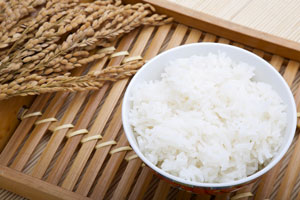Jul. 13, 2012 Research Highlight Biology
Seeking a splice for better rice
A survey of genomic contributions to metabolic activity in rice reveals a bounty of information that might steer future efforts at crop enhancement
 Figure 1: Rice is a core component of the diet of billions of people. Identification of the genetic factors that make the plant more robust, or nutritionally beneficial, may further boost the usefulness of this crop. © iStockphoto/ hanhanpeggy
Figure 1: Rice is a core component of the diet of billions of people. Identification of the genetic factors that make the plant more robust, or nutritionally beneficial, may further boost the usefulness of this crop. © iStockphoto/ hanhanpeggy
Every organism produces a staggering variety of molecules, each with its own particular biological function. Complex interplay between genetic and environmental factors determines the production levels for each compound. By deciphering these factors, plant geneticists can use the information to derive organisms with useful properties, such as crops that are more resistant to pathogens.
A research team led by Kazuki Saito and Fumio Matsuda of the RIKEN Plant Science Center in Yokohama has begun to unravel how genetic variations affect metabolite production in rice, a core dietary staple around the world1 (Fig 1). Saito’s group, which has acquired considerable expertise in characterizing the chemical contents of plants, partnered with agricultural specialists at Japan’s National Institute of Agrobiological Science (NIAS) in Tsukuba. “NIAS is the leading research center for rice breeding in Japan and has developed useful experimental lines for genetic analysis of rice qualitative traits,” says Saito.
Saito, Matsuda and their colleagues examined 85 different lines generated via crosses between cultivars representing two different types of rice, known as Indica and Japonica. “Indica rice is fluffy and used for curry dishes, while Japonica short-grain rice is the moist, sticky, bright white rice used in sushi or risotto,” explains Matsuda. From these various lines, the researchers collected data describing 759 different metabolites. Then they determined the extent to which genetic variations associated with Indica or Japonica genomes correlate with differences in the levels of these compounds.
Although many metabolites appeared to be primarily modulated by non-genetic factors, Saito, Matsuda and their colleagues identified several molecules whose production is strongly affected by differences at particular genomic loci. The researchers even identified a ‘hotspot’—a cluster of loci on chromosome 3 that coordinates production of a number of different amino acids and fatty acids.
Rice plants produce molecules known as flavone glycosides, which protect them from consumption by herbivores but also exhibit antioxidants and anti-inflammatory properties in humans. These could therefore represent promising targets for crop engineering. The research team found clear evidence for heritable factors that affect production, including an Indica-specific variant that is associated with greatly elevated levels of one particular flavone glycoside.
Finer mapping will be needed to pinpoint pertinent genetic alterations, as a possible prelude to targeted modification and optimization. However, this work also reinforces the value of ‘old-fashioned’ genetic engineering techniques. “Our study demonstrates that the metabolic composition in rice grains can be improved by traditional breeding programs, using natural genetic variations in the rice population,” says Saito.
References
- 1. Matsuda, F., Okazaki, Y., Oikawa, A., Kusano, M., Nakabayashi, R., Kikuchi, J., Yonemaru, J., Ebana, K., Yano, M. & Saito, K. Dissection of genotype-phenotype associations in rice grains using metabolome quantitative trait loci analysis. The Plant Journal 70, 624–636 (2012). doi: 10.1111/j.1365-313X.2012.04903.x
